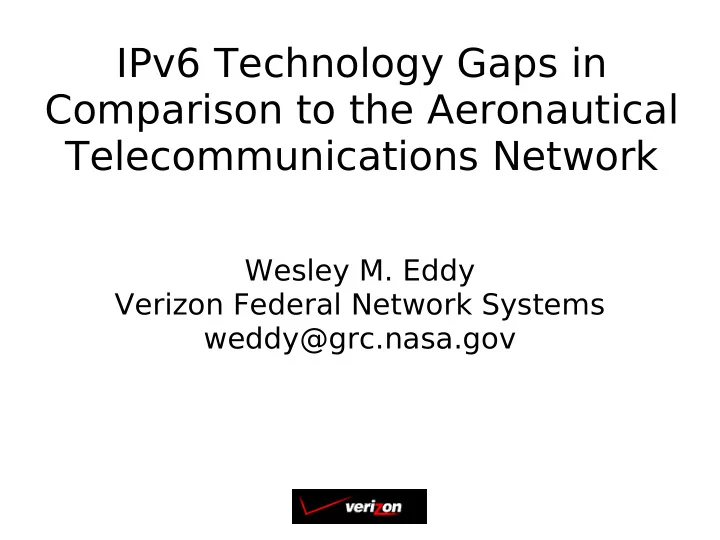

IPv6 Technology Gaps in Comparison to the Aeronautical Telecommunications Network Wesley M. Eddy Verizon Federal Network Systems weddy@grc.nasa.gov
Presentation Outline ● Assume familiarity with TCP/IP ● Introduce ATN ● Compare ATN to IPv6 – Mobility, Policy Routing, Multihoming, Security ● Identify work to be done on IPv6! – Both research and standards development
Meet ATN ● Complete stack designed specifically for niche of aeronautical communications – Air Traffic Services (FAA/Eurocontrol/etc) – Airline Operations – Passenger Services ● Augment/Supplement/Subsume/Replace several systems – ACARS / FANS – ADS / CPDLC / VHF Voice
Based on ISO OSI (!) ● Complete 7-layer stack ● Key Modifications from OSI: – Security framework – Compression for air-ground links – Routing protocol additions for policy routing and mobility
ATN Subnetworks ● Ground-Ground: X.25, Ethernet, SONET, usual suspects ● Air-Ground: VHF Data Link (VDL), Mode S, HF, Gatelink ● Avionics: LANs, e.g. Ethernet, FDDI, AFDX (Deterministic Ethernet) ● Routing by domains and inter/intradomain routing protocols ● Just like TCP/IP ...
ATN Naming/Addressing ● Hierarchical scheme used for: – Network Layer Entities – Network/Transport/Session Users/Apps – Routing/Administrative Domains – App/Presentation Context – Managed Objects – Everything Else ● All in X.500 ... NOT AT ALL LIKE TCP/IP
TCP/IP Naming/Addressing ● Mess of: – DNS – IP addresses – IANA protocol numbers & port assignments – ASNs – SIP, email, URI, etc – /etc/{hosts,protocols,services}
QoS ● ATN defines 14 app categories with distinct transmission priorities – Used inside CLNP headers – Range from distress calls to passenger entertainment ● Very similar to Diffserv – Just more tightly defined
Security ● ATN has application and routing protocol security functions based on: – Elliptic Curve Diffie-Hellman (ECDH) – HMAC (keyed hash) – X.509 ● IPsec and TLS provide these (and more) – Better algorithm agility – Eggs not all in one metaphorical basket ● Neither suite has jamming or identity protection countermeasures
Yet, IPv6 is Needed ● GAO / OMB advice ● DoD interoperability ● Cheaper total cost – Protocol maintenance – Personnel Training – Equipment manufacturing
IPv6 Policy Routing ● For Air-Ground links, desire to use cheap links first, never let passenger traffic onto ATC links, etc ● ATN integrates policy exchange along with the IDRP routing protocol messages between mobile router and access router ● There are no existing IPv6 protocol mechanisms for policy exchange – IETF monami6 efforts should help, although this will be mobile element to home agent
IPv6 vs ATN Mobility ● Mobile IPv6 (MIPv6) and NEMO are tunnel- based ● ATN mobility is routing protocol-based – Achieved through IDRP routing protocol – Scope is limited to speed convergence (doesn't influence IS-IS for example) – Very similar to using OSPF for MANET in IP world
Mobility Differences ● The two mobility approaches are fundamentally different – Route optimization is end-node job in MIPv6 ● Not supported at all (yet) in NEMO (!) – Tunnel overhead in MIPv6 / NEMO ● Both bit-bloat and latency – QoS marks – hidden in tunnel or inconsistent meaning ● ATN's approach avoids all such issues
Multihoming ● IPv6: – None – Addressing is not Provider Independent – IETF shim6 efforts will produce site-based solution ● In ATN, the AS structure is entirely different, so this is no problem for the routing protocol
Promising R & D Topics ● IPv6 policy exchange – Can monami6's solution do all that ATN can? ● IPv6 Network Mobility – Can adequate NEMO route optimization techniques be found? ● IPv6 multihoming – Is the shim6 solution preferable to Provider Independent addressing? ● More ... talk with or email me
Recommend
More recommend